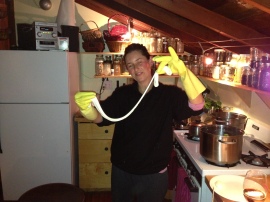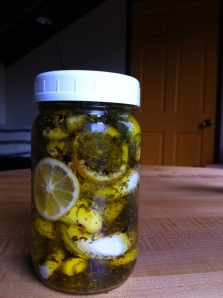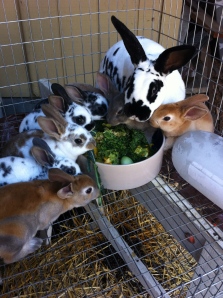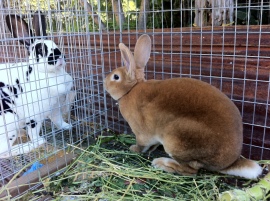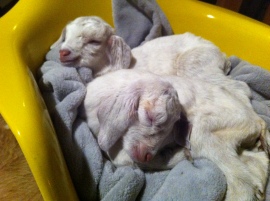Sweet Teats Creamery
Tales of a fledgling creamery in CaliforniaMozzarella Success!
Mozzarella is not an easy cheese. It is harder than making a hard cheese. Which is why I set a goal of figuring out this challenging cheese before my goats freshen this spring. (Right now there isn’t much milk, so it is a good time to experiment on small batches, and learning new skills). I had done quite a few batches of mozzarella, but could not get the “stretch” that changes the structure of the cheese, and gives it that familiar texture.
A few nights ago, I finally succeeded. I had used book recipes in the past, to no avail. If anyone is interested, I’ll gladly give you the recipe I devised. It is not that far from the ones I’ve found in books, but I’ve made all the changes I’ve found to be necessary. It isn’t as creamy as higher cream mozzarella, as goat milk is naturally homogenized and extracting cream is not possible without really fancy equipment.
I fell asleep with a smile on my face that night… next year- homegrown tomatoes and goat mozzarella! The next morning, I decided to marinate some: with olive oil, chili flakes, oregano and herbs de Provence, fresh garlic and some Meyer lemon.
More Protein Production: Rabbits
I finally got the rabbit production underway! This photo is a little old- this was the first litter. I’m now up to 3 breeding pairs of rex rabbits. Three reds, one broken black, one broken blue, and one solid blue.
I’ve chosen to raise rabbits for meat because they are easier to process than other critters. I despise plucking poultry, and goats are an obligation but require a lot of freezer space and about 2 hours. I wanted to raise something that I could keep alive until I was hungry, and then go get an animal for dinner. Bunnies are easy- they are like cleaning fish. And my goodness, they are cute to watch grow up! And the color genetics are so fun to watch play out.
One of the most major challenges I’ve encountered so far: predators. Specifically bobcats. One ate the toes off many of my baby bunnies (they were about 2 months old, and so were big enough to justify eating). It really makes me angry when another critter tries to eat MY food. So they now live in a double enclosure: individual cages in a predator-proof “bunny barn”. Needless to say, it has been somewhat expensive putting together the infrastructure for this project. And making constant changes. I had been wanting to raise rabbits for about 3 years now, and just finally got going last spring. I have yet to have a bounty of meat, more than a meal here and there- always wanting more. I’m hoping to build it up enough to have a bit of excess, for the neighbors, or to sell *live* to the nearby restaurants or friends.
… And the cages are now stacked. 24″x 36″ per rabbit, three high with trays. I originally had them all horizontal so I could easily rake the manure out, but the necessity to have them all enclosed in a barn (large shed) limits the square footage. I do find that the trays make me more diligent about cleaning.
PS: rabbit manure is not “hot” like chicken or cow, it can be applied directly to soil and gardens as fertilizer (as can goat manure).
Birth to Table Dinner: 30th Birthday
One of my sweet Does, Bonnie, had twin boys. And as you know, there isn’t much need for extra males. Some people sell them at the livestock auction, but I don’t feel that this is an honorable end for my hand raised, free-range goats.
I have also developed the personal philosophy that I do not deserve to eat meat if I am not capable of producing and processing it myself.
So, Bonnie’s twins were born on a rainy evening. I got home, all the other goats had returned to the barn and Bonnie was missing. When I found her, she was way down a canyon diligently sanding by her newborns…who were drenched and cold. They got to come into the house for the evening, warmed with dry towels and a hairdryer until they were warm enough to return to their mama.
So when my 30th birthday arrived about 6 months later, I chose to mark the occasion by serving my first birth-to-table goat. That might sound a tad morbid, but I felt that it marked an important year with a marker of how far I’ve come in my quest to produce my own food. And my respect for the animals I care for… they deserve a graceful end and a celebration in their honor!
Researching Rabbits-Housing
So, I had some pet rabbits as a kid. But this time I’m starting from scratch… which means that I get to make all the decisions at once. This required a bit of research on the old internets.
I’ve just ordered the infrastructure: cages etc. This took a little research, because I have not bred rabbits before. If you consider that a female can produce 2 litters in 2 months, but it takes 2 months to raise a litter to weight, you will have to have “extra” rotation cages. Online I have found the suggestion that you should have enough cages, such that 30-90% will be empty at any point. What I have deduced this to mean, for my scale, is that I am starting with 5 36″x24″ cages, and ideally one male (buck), and two females (does). In all likelihood, I will probably only start with breeding one of the females till I get the hang of the breeding schedules, rotations, and am confident that I have enough space for everyone.
We have decided on a nice spot in the goat pen. They have to be in the goat pen, because it is the ‘safe zone’, where a guardian dog presides over all our creatures that are considered tasty treats by the resident lions (and coyotes, and bobcats, and foxes). The biggest concern for rabbits is overheating, so they will be under some redwoods, positioned in such a way as to never get direct sunlight. The cages will be elevated (imagine sawhorses), and be covered by a bottomless plywood box, and the front will be openable to expose the cages. I’ve basically built this same thing before. The feeders and water bottles attach to the front of the cages, and will be protected from the goats curiosity by the box when it is closed. Simple, effective, easy to use and access. Hopefully some photos to follow!
Cheese Hiatus! (Breeding Rabbits)
It is Winter… and because we try to breed all the goats at the same time, that means there is little to no milk in the winter. This year, I had a snafu with the buck hopping a fence in June, and we had a few ‘accidents’ kids born In the end of November, and December. So although this means no break from milking, at least we still have fresh milk thought the winter.
The bulk of the goats will be kidding any minute now, and then there will be copious amounts of milk, and cheese to be made.
But In the meantime, I have devised yet another project: Meat Rabbits! In the past I have raised ducks for meat, but they were a (delicious) hassle. They didn’t really like to hatch their own eggs, which led to a whole slew of problems: re- integrating baby ducks into an established flock, keeping the ducklings dry and warm (they are constantly getting soaked to the bone in the waterer, an with no mom to rub oil on them, no protection this often led to hot baths and a hairdryer to get them warm). And though they were so, so very delicious, there was also the issue of plucking, which doesn’t particularly appeal to me… and not much that can be done with the many feathers.
So I have kept a small flock of ducks as layers. and am moving on to a well-thought out meat source.
Rabbit Meat:
-Rabbits breed easily
-Easily housed/segregated, so I control the breeding schedule
-Short gestation 28-31 days
-Quick growth: about 10 weeks for the breed I’ve chosen.
-Easy to care for/ grow
-Incredibly easy to skin & clean the carcass
-Fur as a commodity
So, basically I’m in it for the meat, the fur is a bonus, and extra points for the fact that rabbits are basically the easiest meat to clean (at least as easy as a fish, since most people have probably cleaned a fish, but not necessarily a rabbit).
The breed I am choosing is Rex. They are a large rabbit that isn’t used commercially because they aren’t the biggest of the big. But they have the most incredible fur… it is like chinchilla, or dense, very soft velvet. I am expecting that they should reach ‘fryer’ weight at about 10 weeks, rather than the 8 weeks allotted for commercial rabbit breeds. If you are on the 8 week schedule, this means that a doe (the female) is producing a litter about every month. Time to buy a freezer, I suppose. I’m hoping that the group- 2 does and one buck- will produce a good amount of food for myself (a rabbit a week?), some for my gracious landlords, and a few to sell. Hopefully selling some will offset the feed costs, so that the rabbits we eat aren’t costing anything.
Yum.
Goat Milk Soaps

I have been making Goat Milk Soap. It is really lovely, pure soap that doesn’t dry out the skin… I even use it on my face. And it is something that I can actually choose to sell. After experimenting with various shapes (using silicone baking molds), I decided on a ‘gold bar’ shape. I was originally using a flat-topped pyramid because I liked the physical reference to Valencay cheese, but after talking to a few places about selling the soap I realized that I had to deal with labeling and packaging. So the ‘gold bar’ shape will allow for some sort of paper wrapping, and probably a stamp on the soap itself.
I haven’t really addressed the packaging yet, as it seems like an expensive hurdle. I would like to have a metal die cut for the stamp on the face of the soap, and the wrapper lasercut.

This is the template I have been using for a wrapper. I’ve been using brown waxed paper, which looks nice… but it takes me about 3 minutes to cut out a wrapper, so I need to have them mass-produced.
Feeding our Friends
We took some of our cheeses to a small winetasting with friends recently. It was quite exciting, as many of the cheeses were just now reaching maturity and we hadn’t tried any in a while.
 … And displaying the cheeses was nice… I tell people I spend time making cheese, and sometimes it seems like a myth because we don’t make enough to sell it.
… And displaying the cheeses was nice… I tell people I spend time making cheese, and sometimes it seems like a myth because we don’t make enough to sell it.
The event justified my curiosity in opening some of the large wheels (8lb) that have been aging for 3-4 months+. There were a few I was worried about- one that had used milk that sat out overnight (should have fed the milk to the animals- the cheese had all sorts of off flavors). Another I had accidentally overheated the milk. And the third bad wheel had blown- It went into the cave during a heat wave and the cave was too warm… it has beautiful lacy-swiss gas holes, but it doesn’t taste like it should. Everything else I’ve opened has been amazing though, and gives me the confidence to continue.
This was an aged wheel (3 months) with dried peppers from the garden. I think the peppers were chipotle, but I really don’t know. I don’t promote “cheese with stuff in it” (or on it), because I believe it takes away from the quality of the cheese (or covers up the low quality, which is more often the case), but I was feeling silly the day I made this one. If I were to do it again, I would use 10x the amount of pepper, because it was hardly noticeable in the flavor. The challenge with the peppers is that they disrupt the smoothness of the rind, and make the rind very irregular as if it was cracking. I prefer the rinds to be perfectly smooth, so that the cheeses seal in the moisture.
The New Cheeses are Delicious!
 I was getting nervous about the new cheese, in the new cave. Particularly that they were losing too much moisture because I use the cave both as a drying room and as an aging cave.
I was getting nervous about the new cheese, in the new cave. Particularly that they were losing too much moisture because I use the cave both as a drying room and as an aging cave.
I decided to cut open one of the smaller wheels to see where it was at. I was more concered about this wheel than the others because it was rather small- it was a 5-6 gallon batch, so I suspect it weighs just a hair over 4lbs. At this size there is proportionally more rind to interior, so I figure it is drying and aging a bit quicker than the wheels that are about twice the size.
… I was pleasantly surprised! It had a really nice crumble-y texture, but the rind had dried nicely and totally sealed in the desired moisture. And the flavors were young, but correct (and no off flavors). Im very excied, because this was the first ‘good’ wheel that I opened… I was still getting my bearings on the new location/ equiptment, and larger scale on the first two- which were edible, but nothing I was proud of. The Kadova mold makes a huge impact because it gives such a smooth rind, so the rind dries quickly and evenly, sealing in the moisture. Also, we decided on a secondary culture, which was a group decision because it will begin to inoculate our cave over time, but has been a savior in keeping all the undesirable molds/ yeasts/ bacterias at bay.
The New Cheese Cave
 How serendipitous is the new home? It had a fresh built cheese cave… ready for me to fill with goat cheese!! Oh my, I still cant believe it!
How serendipitous is the new home? It had a fresh built cheese cave… ready for me to fill with goat cheese!! Oh my, I still cant believe it!
I started making the full size wheels about a month ago. They require a minimum of 2 months aging- to meet hypothetical ‘raw milk’ laws* . They vary in size- I work full time, and on the ranch, so I can usually manage a day a week to make cheese. The decision to make hard or soft cheeses is highly subjective, as hard cheese require a block of time (5-6 hours usually) initially, but once unmolded, very little maintenance. Soft cheeses (lactic body), on the other hand, require very little time up front, but lots of steps over a few days, and then more rind maintenance as they age. And to be honest, the cleanup is much easier for hard cheeses… the whey is much ‘cleaner’ and very little is left on the equipment.
*we are only able to make enough cheese to feed ourselves (immediate family), but still follow clean artesianal traditions.
The New Homestead
Its been ages. I have not had a functional computer, or internet, and lived without electricity for many months. And now… Im back in civilization… still a long ways from the nearest town, but re-settled. And hopefully blogging consistently again!
My relocation involved integrating with another herd/family/cheesemakers. So Happy! it was a match made in heaven- they had been specializing in soft chevre for many years, and I had spent my hours perfecting hard cheese. And there was a cheese cave, empty, ready to use! so we had the conversation about what to indirectly inoculate the cave with. We settled on an inadvertent b.linens, because I have found that without washing, it can be a latent secondary culture that keeps the ‘unintentionals’ at bay. It also gives a nice flavor to the cheese.
The most exciting part is that I now get to do FULL SIZE WHEELS!!!!! Weeeeeee! It has been a long year++ of research, intuitive learning, and development of my cheesemaking skills on small batches. And now? 6-10 lb wheels! Luckily we eat a lot of cheese on this ranch!
The timing is perfect, I have full faith in the large wheels of cheese, faith in my skills that I didn’t have in the beginning. There are a few in the new cave… the oldest ones are about a month old, and they will be aged for at least 2 months for the smaller wheels, probably 3 or 4 for the largest.
And thanks to my sweet mother, who got me a large, beautiful mold for my birthday! The Kadova molds have made aging the hard cheeses MUCH easier, because they give a very smooth surface to the cheese, so you don’t have runaway mold escaping to the interior of the cheese.
